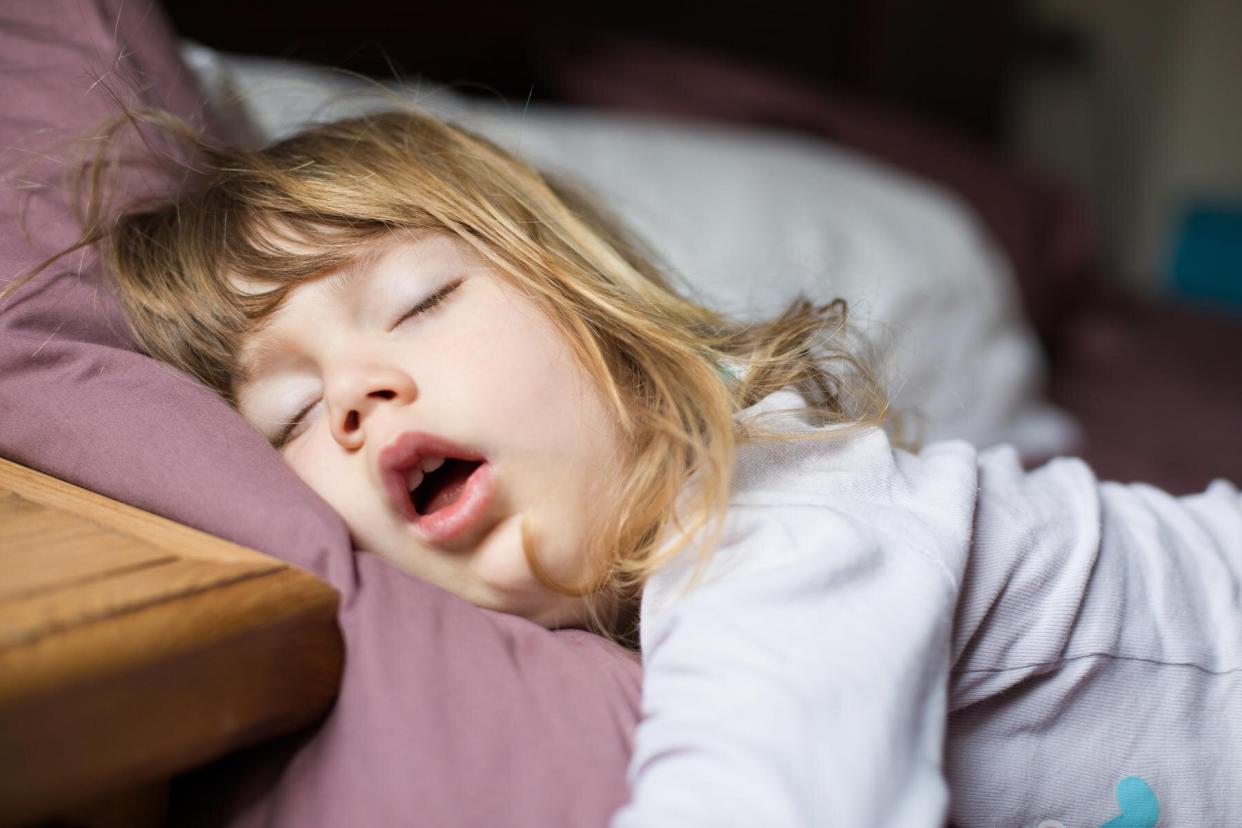Signs of Sleep Apnea in Children and How to Help

Quintanilla/Shutterstock
Obstructive sleep apnea is a disorder characterized by blocked or narrowed breathing passages that cause people to snore and stop breathing briefly while asleep. Anywhere from 1 to 4 percent of kids have apnea, according to the American Sleep Apnea Association. It usually occurs because their tonsils or adenoids are enlarged.
Untreated, sleep apnea in kids can lead to developmental and behavioral problems, including an increase in night terrors in a child who's predisposed to them. Treatment (usually the removal of adenoids and/or tonsils) can be very effective.
RELATED: The Ultimate Guide to Easy Bedtimes
Signs of Sleep Apnea in Children
Large tonsils and adenoids lead to obstructive sleep apnea, since they create a blockage in the throat or nose. Risk factors include obesity, family history, low birth weight, facial or skull abnormalities, and conditions like Down syndrome, sickle cell disease, and cerebral palsy.
If your child has night terrors and any of the symptoms below, have him evaluated for obstructive sleep apnea, says Judith Owens, M.D., director of the Center for Pediatric Sleep Disorders at Boston Children’s Hospital.
Snoring—it's the most common sign.
Pauses in breathing during sleep.
Breathing through the mouth, both while asleep and awake.
Contorted sleep positions, as your child unconsciously maneuvers himself to try to breathe more easily
Noisy breathing, coughing, and choking while asleep.
Short-term wakefulness in sleep due to interrupted breathing.
Unusual grumpiness in the morning.
Persistent bed-wetting in a child who snores loudly and frequently while asleep.
Hyperactivity, mood swings, irritability, and/or inattentiveness during the day because he isn’t getting solid sleep at night.
The Link Between Snoring and Sleep Apnea
Most people think snoring means someone is in a deep sleep, but the opposite is actually true, says Dr. Owens. If your child snores, she could be a restless sleeper who isn’t getting adequate shut-eye at night. It’s also possible she has sleep apnea, which can start up at any age for toddlers, preschoolers, and school-age children.
RELATED: The 7 Reasons Your Kid Needs Sleep
Take a video of her sleeping to show the doctor. Keep track of how loudly she snores and whether it happens every night or only once in a while (when she has a cold or seasonal allergies). Also, pay attention to whether she has breathing pauses, makes any choking or gasping sounds, or moves a lot when she sleeps—all potential signs of sleep apnea.
Sleep Apnea Treatment
Since children with sleep apnea don’t rest well, they could suffer during the daytime. Poor academic performance and hyperactivity, for example, may sometimes be associated with sleep apnea—and this could lead to a misdiagnosis of attention-deficit/hyperactivity disorder (ADHD). Untreated sleep apnea can increase the risk of high blood pressure, obesity, and future heart attack. It could also impact “motor skills, creativity, and problem-solving skills,” says Dr. Owens says.
If your pediatrician diagnoses enlarged tonsils or adenoids (the most common cause of apnea in kids), he may refer your child for a sleep study in a sleep lab and also to an ear, nose, and throat (ENT) doctor. Mild cases of sleep apnea in children might not need treatment, since the condition sometimes disappears on its own.
RELATED: 12 Steps to Sleep-Training Success
If your doctor does decide to move forward with treatment, though, he may discuss topical nasal steroids or removal of tonsils and adenoids. Another option is wearing a special dental appliance at night to open airways. Finally, a child could use a CPAP (continuous positive airway pressure) mask that covers his nose and mouth to provide non-stop airflow.

